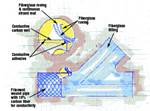Fiberglass Ideal For Dry Deluge System Applications
Around 1982, offshore platforms began using dry deluge systems, where the ring main is kept full of seawater but the downstream piping is dry. The dry piping is separated from the ring main by deluge valves, which automatically open and distribute water through the dry pipe to spray nozzles during a fire. This
Share
Read Next
Around 1982, offshore platforms began using dry deluge systems, where the ring main is kept full of seawater but the downstream piping is dry. The dry piping is separated from the ring main by deluge valves, which automatically open and distribute water through the dry pipe to spray nozzles during a fire. This practice saves weight and minimizes corrosion-induced that the deluge piping is typically routed to avoid hazardous areas on the platform means that conductivity is not a requirement, but fire resistance is essential.
In 1991, Ameron retrofitted ballast piping and the fire protection line on BP Norway’s Valhall, a fixed-leg platform in Norway’s North Sea sector, using FRP piping to replace corroded steel. The company installed its Bondstrand pipe product, which is made with fiberglass and epoxy resin and Pitt-Char intumescent resin (supplied by PPG Industries, Springdale, Pa., USA) for the pipe’s exterior coating. The coating was reinforced with fiberglass to improve its adhesion to the pipe and add impact and scuff resistance. The pipe passed the HSE Offshore Safety Report OTI 95-634 “Jet-fire Resistance Test of Passive Fire Protection Materials,” a test standard that is accepted by oil companies.
Polysiloxane-modified phenolic resins are also a good choice for dry deluge piping. Siloxane molecules incorporated into the phenolic’s backbone chemistry improve impact resistance, pressure performance and bonded-joint adhesion without sacrificing the resin’s inherent fire resistance. To reduce wall stresses and temperature buildup during jet-fire conditions, extra plies (Ameron uses 10 to 12) of alternating polypropylene veil tape can be wrapped around fiberglass/polysiloxane-modified phenolic piping. Under extreme heat, the veil vaporizes, leaving an air gap and shear layer in the laminate, which can withstand higher heat because of the phenolic but chars when it burns. The result is alternating layers of glass, residual char from the phenolic resin and air gaps from the vaporized polypropylene — a construction that forms a virtual heat shield for the pipe structure. Ameron has supplied 9,000 ft/2,770m of fire main and dry deluge system piping of this type for the BP Marlin platform, which was activated in the Gulf of Mexico late in 2000.
Related Content
-
From the CW Archives: Airbus A400M cargo door
The inaugural CW From the Archives revisits Sara Black’s 2007 story on out-of-autoclave infusion used to fabricate the massive composite upper cargo door for the Airbus A400M military airlifter.
-
Assembling the Multifunctional Fuselage Demonstrator: The final welds
Building the all-thermoplastic composite fuselage demonstrator comes to an end with continuous ultrasonic welding of the RH longitudinal fuselage joint and resistance welding for coupling of the fuselage frames across the upper and lower halves.
-
“Structured air” TPS safeguards composite structures
Powered by an 85% air/15% pure polyimide aerogel, Blueshift’s novel material system protects structures during transient thermal events from -200°C to beyond 2400°C for rockets, battery boxes and more.

